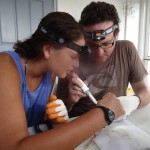This is a guest post by Serena Hackerott, an undergraduate in my lab. In the photo below, Serena is teaching me how to extract the tiny otoliths from a lionfish she captured.
Lionfish are the first marine fish to successfully invade the Caribbean. Lionfish are “piscivores”, or predatory fish that eat other fish, native to the Pacific. Lionfish first appeared in the Atlantic in 2000 off the coast of Florida, where it is suspected that individuals were released from an aquarium. Since their introduction, lionfish have rapidly spread throughout the Caribbean. A lack of natural predators and a phenomenon known as “prey naiveté” has contributed to the success of the invasion. “Prey naiveté” describes the situation where native prey are vulnerable to invasive predators because the prey species do not recognize the novel predator. Lionfish prey on a wide variety of reef fish including juvenile herbivore and predator species. This increase in predation can cause negative changes within the ecosystem such as a decrease in the already low predator biomass or a decline in coral coverage.
It has been suggested that large predators such as grouper or sharks could prey on lionfish and control or reduce the lionfish invasion through a process known as “biotic resistance.” In my project, I am interested in testing this hypothesis of “top-down biotic resistance.” Specifically, my hypothesis is that lionfish fitness will be reduced on reefs with large predators compared to reefs without predators. The second component of my project is related to “prey naiveté” and a form of “bottom-up biotic resistance.” My second hypothesis is that lionfish fitness will be reduced on reefs with a longer lionfish exposure compared to reefs with a more recent invasion (shorter exposure) due to prey species learning that lionfish are predators.
[vimeo]http://vimeo.com/43917152[/vimeo]
To test both hypotheses, I am estimating lionfish “fitness” by measuring the weight of the stomach contents and by measuring growth rate through otolith analysis. Lionfish have two otoliths, or ear bones, that lay down rings similar to the rings of a tree trunk, which can be analyzed using a microscope. Initially, I had planned to do a controlled experiment in the field related to my second hypothesis, but I had underestimated the amount of logistical planning that field experiments require. I am now grateful for the guidance I received from the Bruno lab to focus on the fitness measurements. They, alone, are enough to keep me busy this summer!
During May 2012, I was in Belize with Dr. John Bruno, four graduate students, and a lab tech for the Bruno lab’s annual reef surveys. Using scuba, I collected lionfish with my brand new pole spear, which was an adventure in itself! Everyone in the lab was really helpful and got excited to watch me “hunt lionfish”. It may be because, after I collected the stomachs and otoliths, the lionfish became our dinner! I was soon nicknamed “Katniss,” the girl from The Hunger Games who hunts to feed her family. Everyone took part in the lionfish processing, and on the last day we finished a record of sixteen lionfish in an hour! Now onto the Bahamas in July!


Leave a Reply